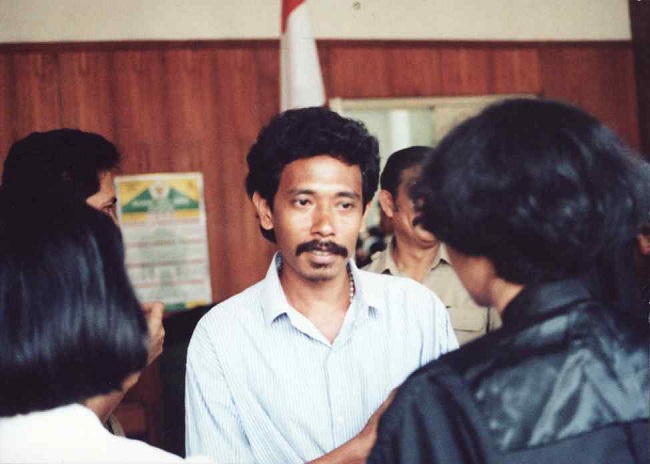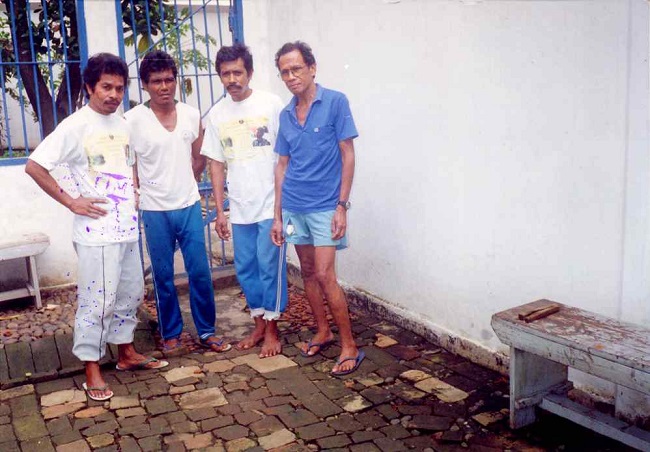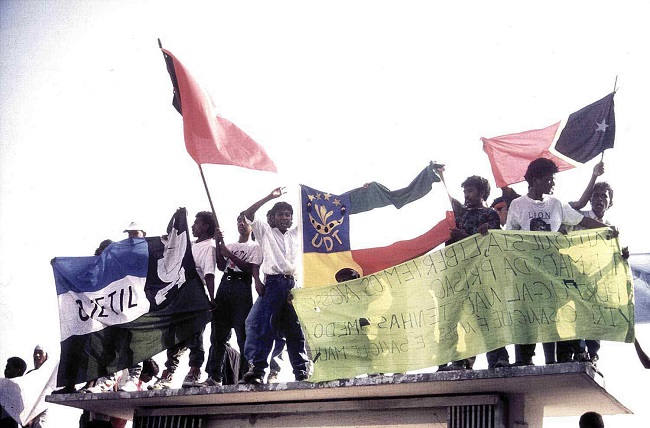East Timor’s student movement and the struggle against oppression
Ivo Mateus Goncalves
In present-day East Timor, post-colonial historiography has mainly focused on the ‘big names’ and commanders of the guerrilla movement as well as the prominence of the diplomatic front in the struggle for independence. Rarely mentioned in this context has been the role of the youth and of students in the struggle against the Indonesian occupation.
On 28 November 1975, East Timor’s interim government unilaterally declared its independence from all forms of colonialism and exploitation. The historical progenitors who dominated at that time were mostly born in the decades of 1930 and 1940, and most of them were able to obtain a proper education under Portuguese colonialism. On 7 December 1975, a week after that historical milestone, the Indonesia army invaded East Timor.
From 1975 until the 1980s, East Timor was surrounded by a culture of silence as Indonesia strengthened their foothold through reaching into every part of Timorese society. Indonesia’s eleven battalions were deployed to almost every district in East Timor and the nation was placed under intense military surveillance.
Organising in silence
This oppression gave birth to resistance and from the 1980s onward, a clandestine movement began to organise in silence. The 1980s and 1990s marked the beginning of the rise of a generation of resistance.
Several liberated zones were established by the resistance in mountainous areas such as Mt Matebian in the east and Ramelau, Kablaki and Suai in the west. Nonetheless, the people simply could not resist the massive scale of Indonesia’s military offensive, which was accompanied by heavy bombardment of areas regarded as ‘resistance strongholds’. Large numbers of civilians surrendered to the Indonesian military.
Following their surrender, people were placed in concentration camps spread around the territory. Ironically, the genesis of the clandestine movement itself had arisen within security hamlets established by the colonial regime. According to some sources, those who played a pivotal role in the ‘second national awakening’ as it is called, were the generation who spent a number of years in the mountains after the invasion, some of whom were born under heavily bombardment. The rest were inspired by their relatives as well as by their experience under the occupation.
Despite being under strict military control, those former combatants who had surrendered were able to build up a network of resistance. Communication between the guerrilla movement and urban clandestine groups was established through couriers and cells. Food shortages led the Indonesian military to allow people to grow their own food, which in turn enabled linkages to develop between the armed guerrilla front and the population under occupation as they provided logistical support.

There was discussion about the future of the resistance, about how to involve the remnants of the Falintil forces, and about how to encourage more youth to become engaged in the resistance. Falintil was the military wing of the political party FRETILIN of East Timor, established on 20 August 1975 in response to FRETILIN’s political conflict with the Timorese Democratic Union.
Constant suppression and student awakening
It is a common feature of oppression that it gives birth to three stages of resistance. First, a society becomes passive due to trauma and there is an unwillingness to resist; then, as the anthropologist James Scott observed, a population under occupation begins to launch its own everyday forms of resistance, that are often barely noticed by the regime. The third stage is reached when the population carries out massive opposition against the occupiers. In the case of East Timor, these three stages occurred as there was movement from a passive state, to silent resistance and finally direct opposition to Indonesian rule.
In the 1980s, the Indonesian government provided a large number of scholarships to East Timorese youth to pursue study in various universities in Indonesia. The aim of this ‘colonial benevolence’ was to integrate East Timorese youth politically and culturally into the Indonesian unitary state through a massive program of educational opportunity. The Indonesian government policy was the carbon copy of the 1901 Ethical Policy of the Dutch colonialists in the then Netherlands East Indies. One such student, Avelino Maria Coelho da Silva, was one of the candidates in the Presidential Elections in East Timor in April 2007. Coelho da Silva had become involved in the clandestine resistance when he was a student of international relations and law in Jakarta. He explained:
‘I came to Dili in the early 1980s and along with a few friends, we established strong bonds which paved the way for the formation of the first student clandestine organisation in the urban area.’
An unwanted result of Indonesia’s policy of educating Timorese in Indonesian universities was the creation, on 20 June 1988 in Denpasar, of the first Timorese student movement organisation, the National Resistance of East Timor Students (RENETIL - Resistencia Nacional dos Estudantes de Timor-Leste). Most of its founders were in their twenties, the eldest being the late Lucas da Costa who was 36 years old at the time. He previously recalled:
‘A few years after invasion, in 1980s, most of our guerrilla force had been swept away by Indonesian military and only a handful of them had survived the Indonesian military offensive. In addition, the population was under Indonesian military control and the situation seemed desperate for East Timor’s future. After surrendering to the Indonesian military, I was thinking about how (we could) transfer the East Timorese war to the Indonesian mainland in order to ignite the support from Indonesian people itself. That was the common objective which lead to the formation of the RENETIL.’
Unlike previous ideas which had identified the resistance movement with one party – FRETELIN (the Revolutionary Front for an Independent East Timor) – RENETIL united the different positions of its founders who came from a variety of political backgrounds including FRETILIN, UDT (the Timorese Democratic Union) and APODETI (the Timorese Popular Democratic Association). Non-partisan elements in the resistance also played an important role.
After the Indonesian military strengthened its foothold in East Timor, a new Indonesian regional governmental structure was established. Several figures who were regarded as local collaborators, mainly consisting of members of APODETI and UDT, as well as a small number of former FRETILIN members, were incorporated into the regional government. However, the colonial policy to win the hearts and minds of Timorese failed as, to some extent, the resistance was indeed born among those same middle and high-ranking government officials. Joao da Silva’s experience is worth quoting at length:
‘My father was a member of APODETI, the pro-integration party. However, in June 1981 the Indonesian military conducted their Operasi Pagar Betis ‘Fence of Legs Operation’. A large number of people were mobilised across 13 districts. My father joined the operation. In the district of Viqueque, he witnessed with his own eyes how the Indonesian military shot, tortured and beheaded people, including a boy whom my father had intended the night before to adopt as his own son. After the military operation, he returned to Dili, but could not even close his eyes without thinking about the boy and the people killed by the Indonesian military. Ever since, he encouraged us to resist the Indonesian military occupation. My father said bitterly: “I myself, supported them to come (invade) our country, I thought they were good people; they said Fretilin was cruel. But what do they do now? We cannot allow this to continue. They have to get out of here."’
From then on, Joao and his older brother Francisco, became more deeply involved in the clandestine movement and the demonstrations that took place in Dili in the following years.

The emergence of the East Timor student movement in the aftermath of the Indonesian invasion kept hope alive for the resistance. When Pope John Paul II paid a visit to East Timor in 1989, the first mass protest took place and was violently suppressed by Indonesian military. A subsequent student and youth protest occurred on 12 November 1991 and resulted in a massacre by the Indonesian authorities at the Santa Cruz cemetery. Human Rights Watch estimate that anywhere between 75 and 200 people were killed. This event sparked bitter criticism from the international community, foreign governments put East Timor back on the international agenda. Among those killed and whose bodies were never found was Joao da Silva’s older brother, Francisco.
Thereafter, continual demonstrations and mass protests became a common feature of life and politics in East Timor, with large numbers of students involved. They had been born a few years after the 1975 invasion and in the early 1980s. The role of this generation was decisive as their votes also led to the popular consultation which ended Indonesia’s 24 year military occupation.
Complex histories
The history of the East Timor independence movement is a multi-generational one. Those born after 1975 were radicalised by circumstances involving family, oppression and the process of decolonisation itself. To understand the particular role of youth in the resistance, more research, including structured interviews with members of the student clandestine movement is needed. How did Timorese youth respond to the political transformation that began in the mountains in the 1980s and culminated with the Santa Cruz massacre?
Moreover, the aftermath of the Santa Cruz massacre itself requires serious further historical exploration. Dozens of East Timorese students were detained by the Indonesian military at this time. They subsequently became members of the Operational Auxiliary Force (Tenaga Bantuan Operasi) that assisted the Indonesian military in carrying their weapons and pursuing the guerrilla movement in many districts. The circumstances they experienced, and how these young men rebuilt their bonds with the community and eventually felt moved to fight the occupation, is one more necessary area of investigation in order to understand the complexity of everyday struggles against foreign domination in Timor and beyond.
Ivo Mateus Goncalves (IvoMateus.Goncalves@anu.edu.au) is a PhD candidate in the Department of Pacific Affairs, in ANU’s Coral Bell School of Asia Pacific Affairs.
